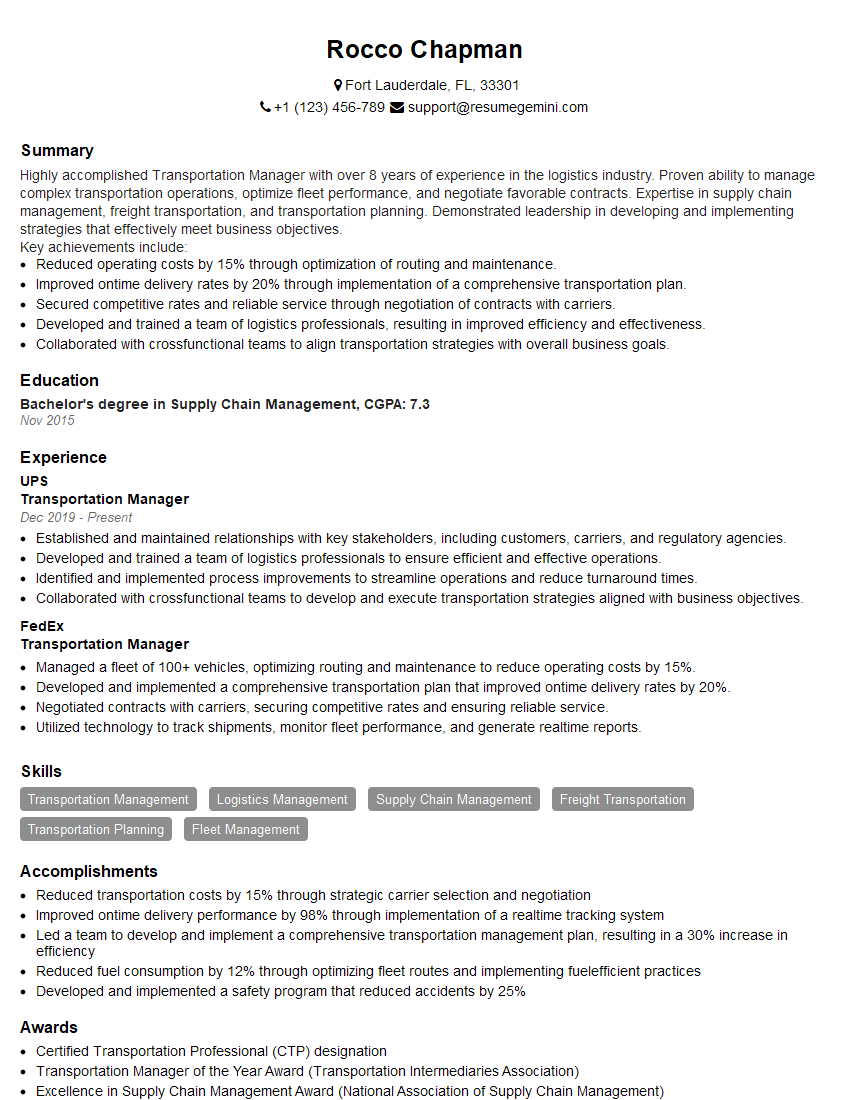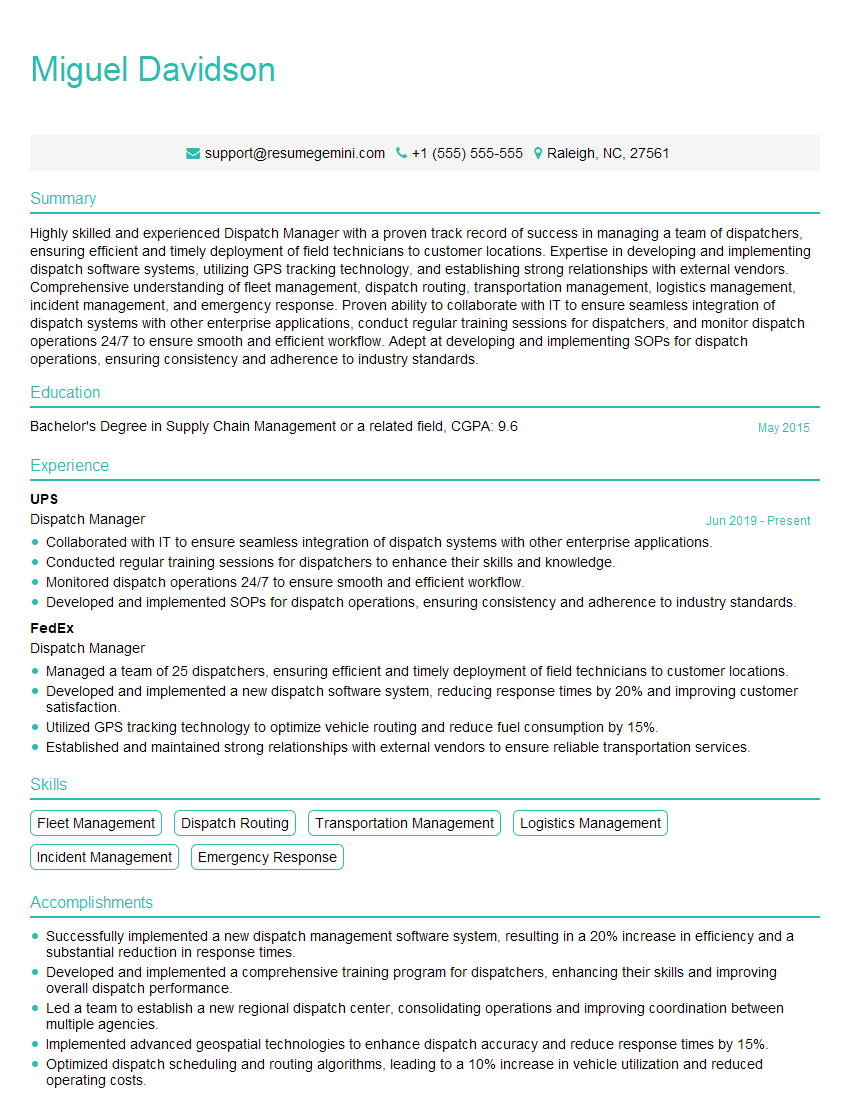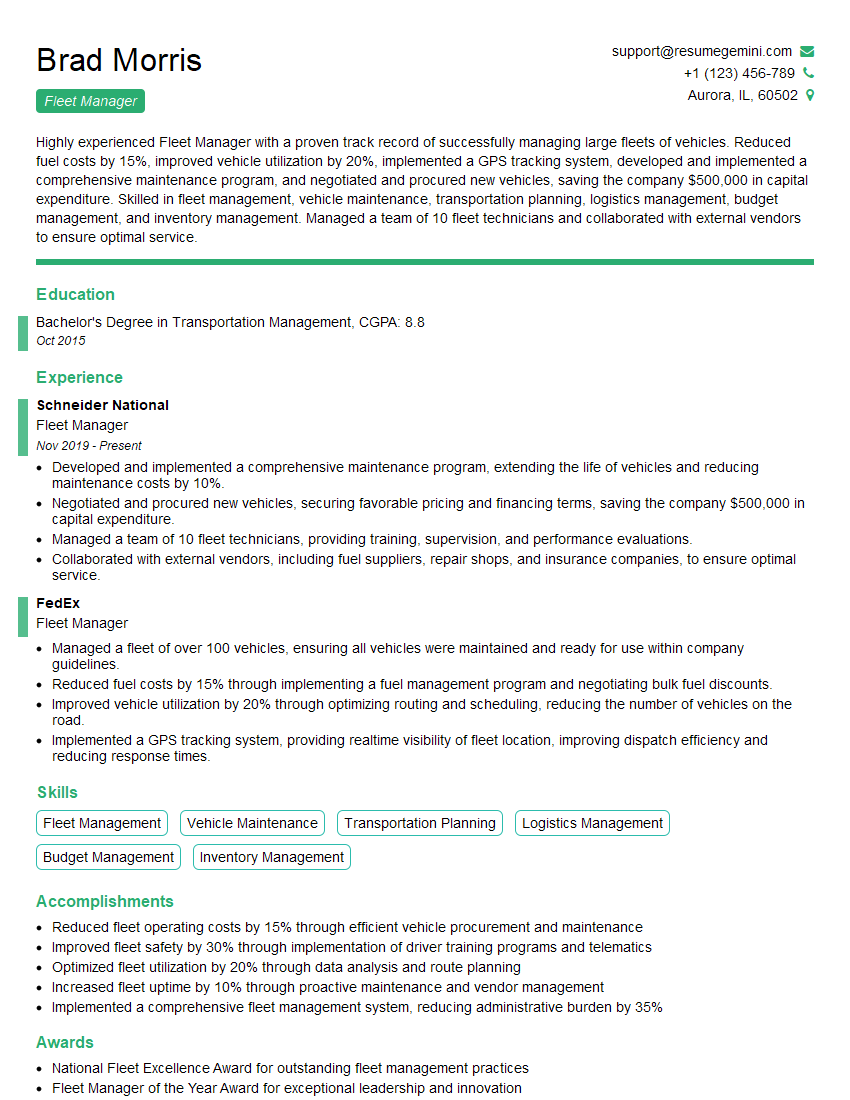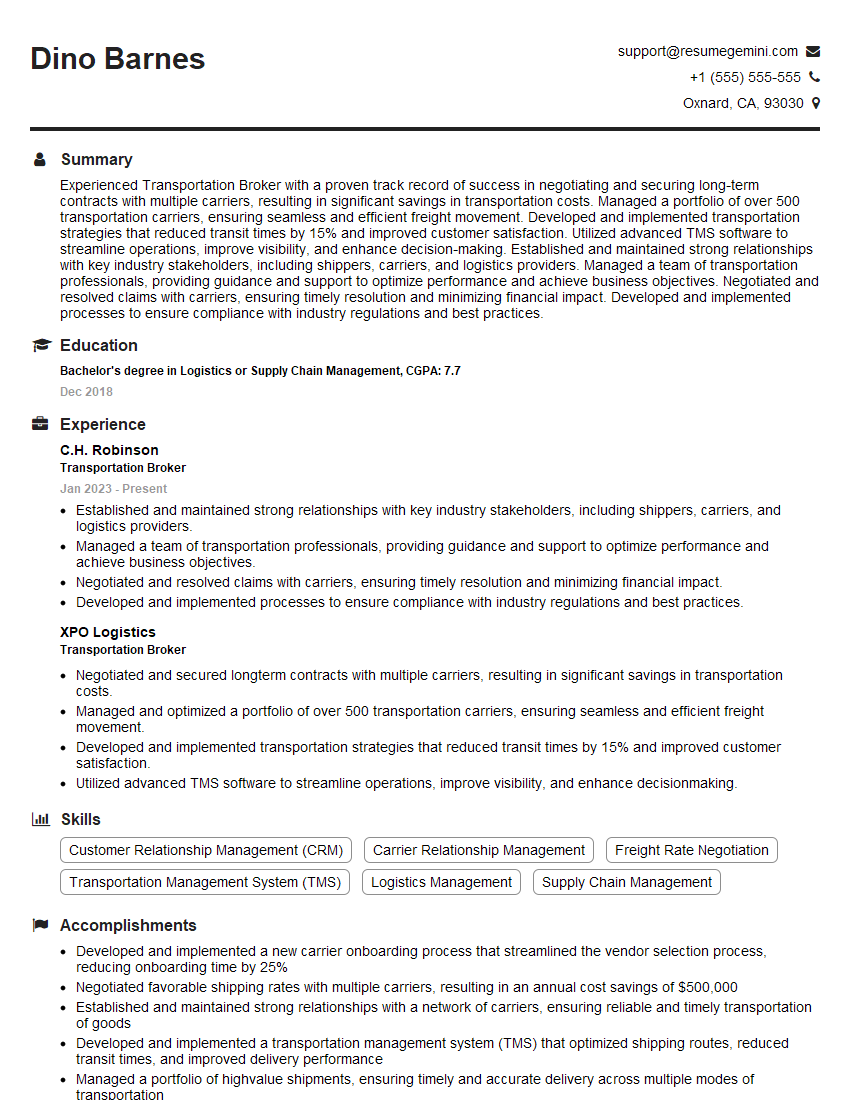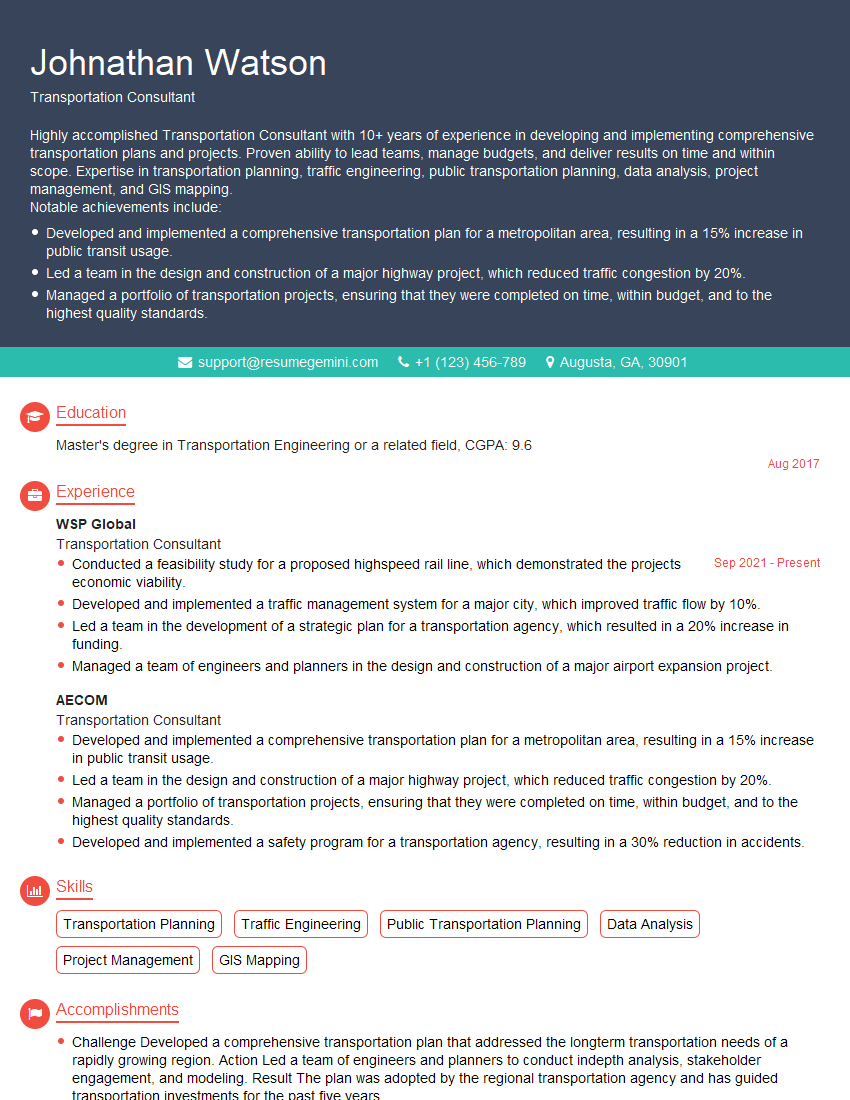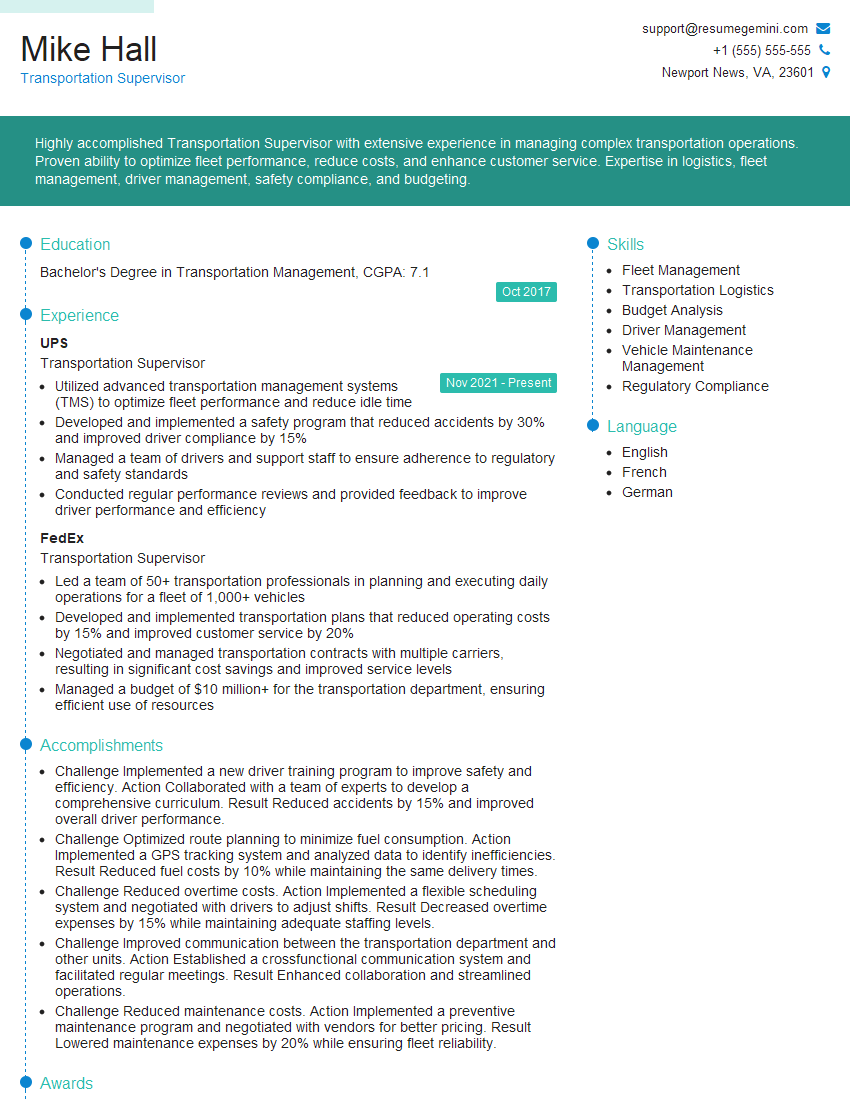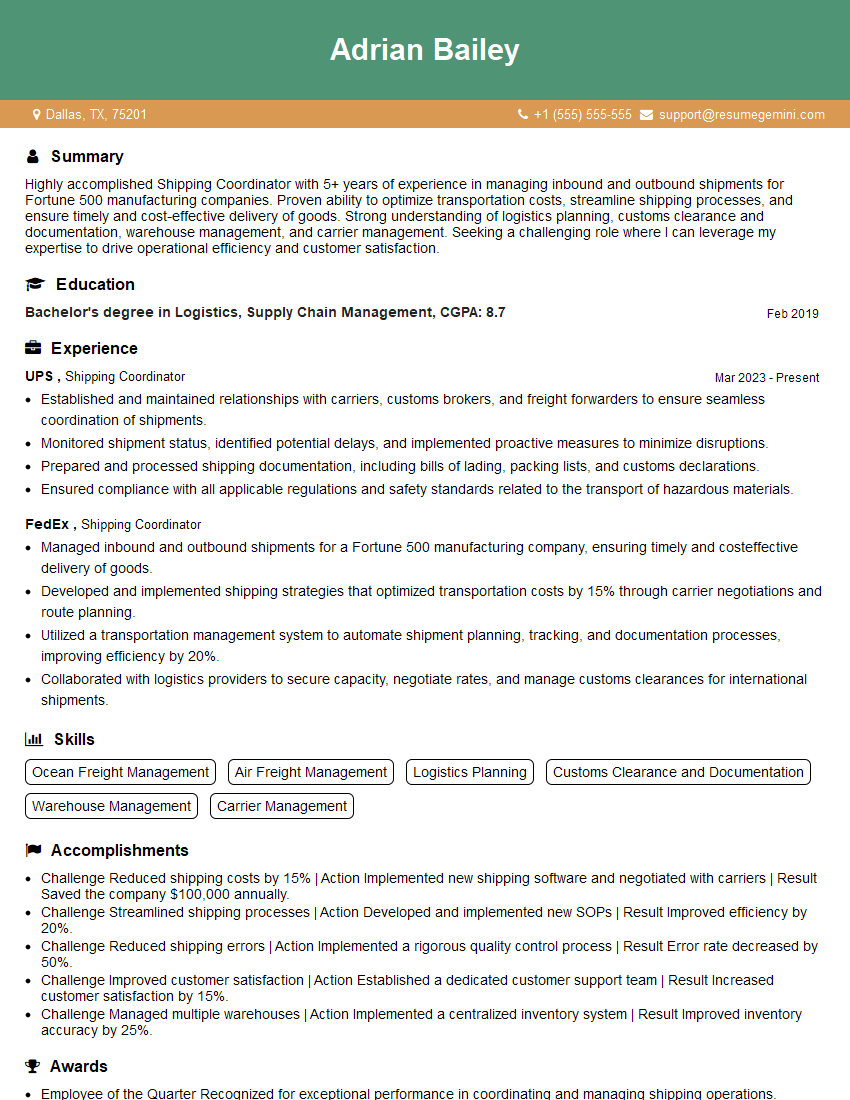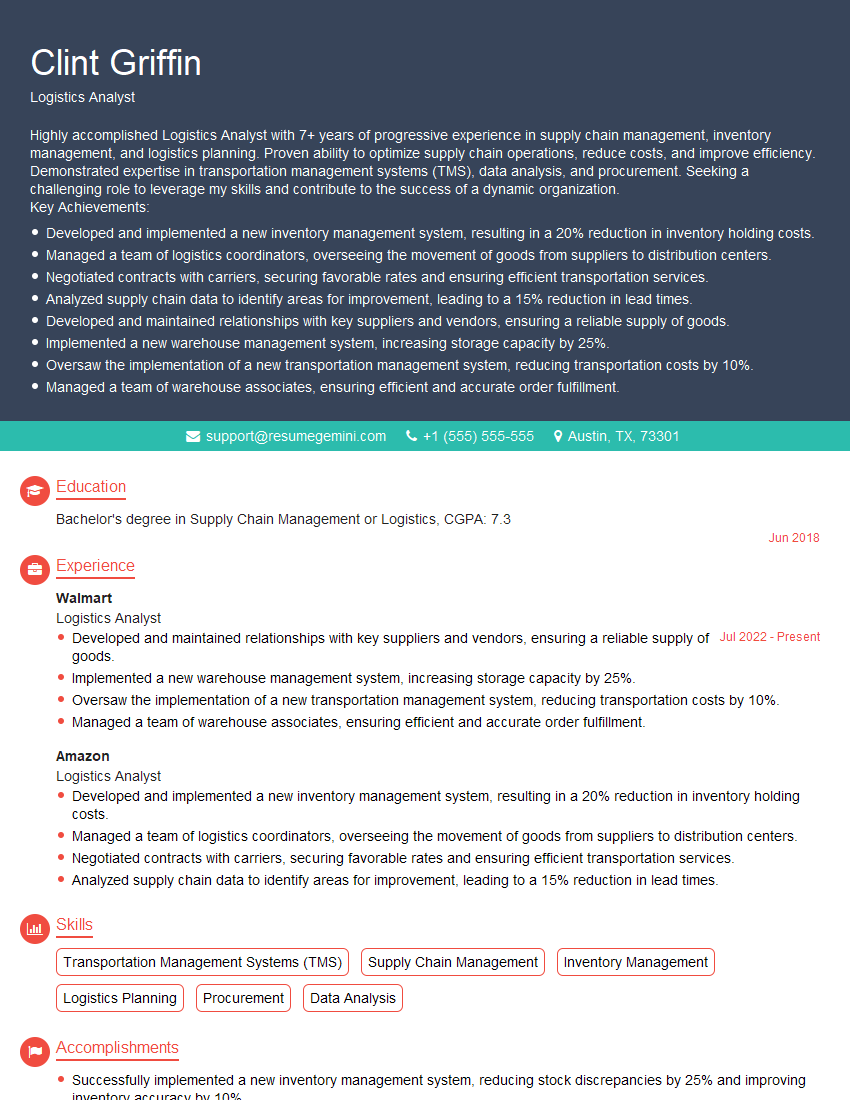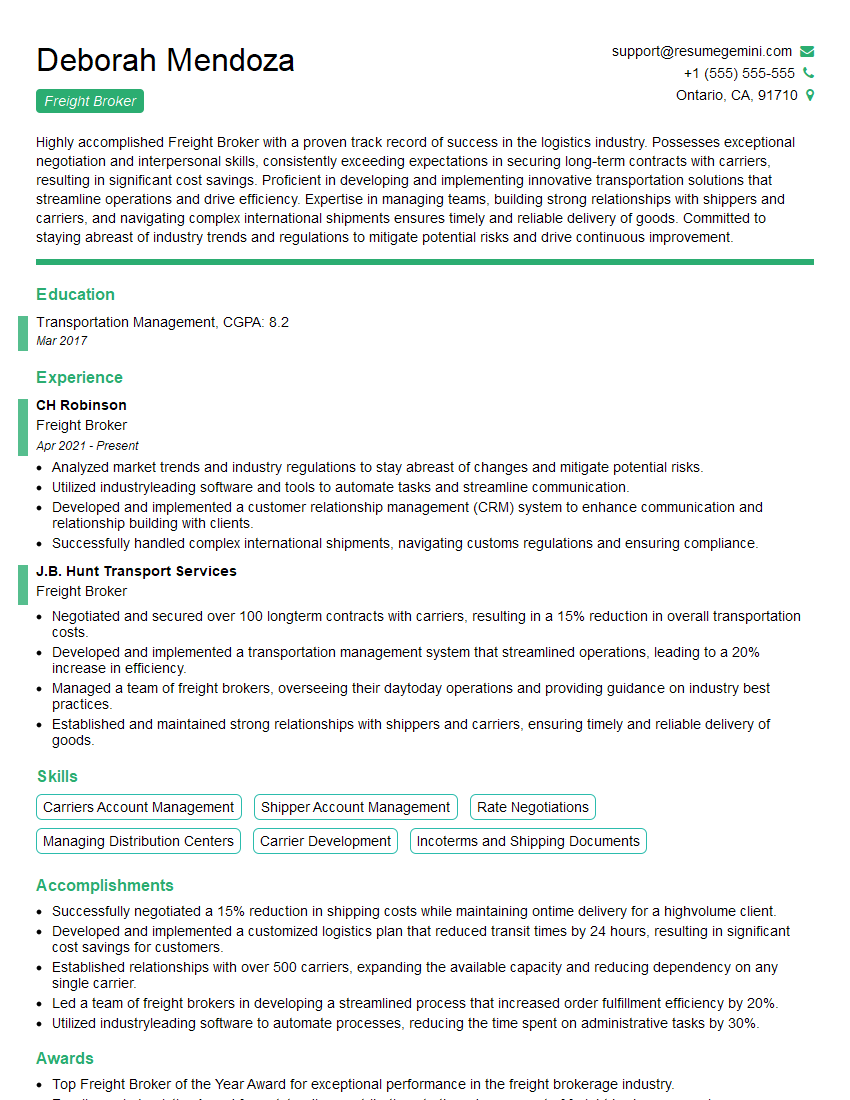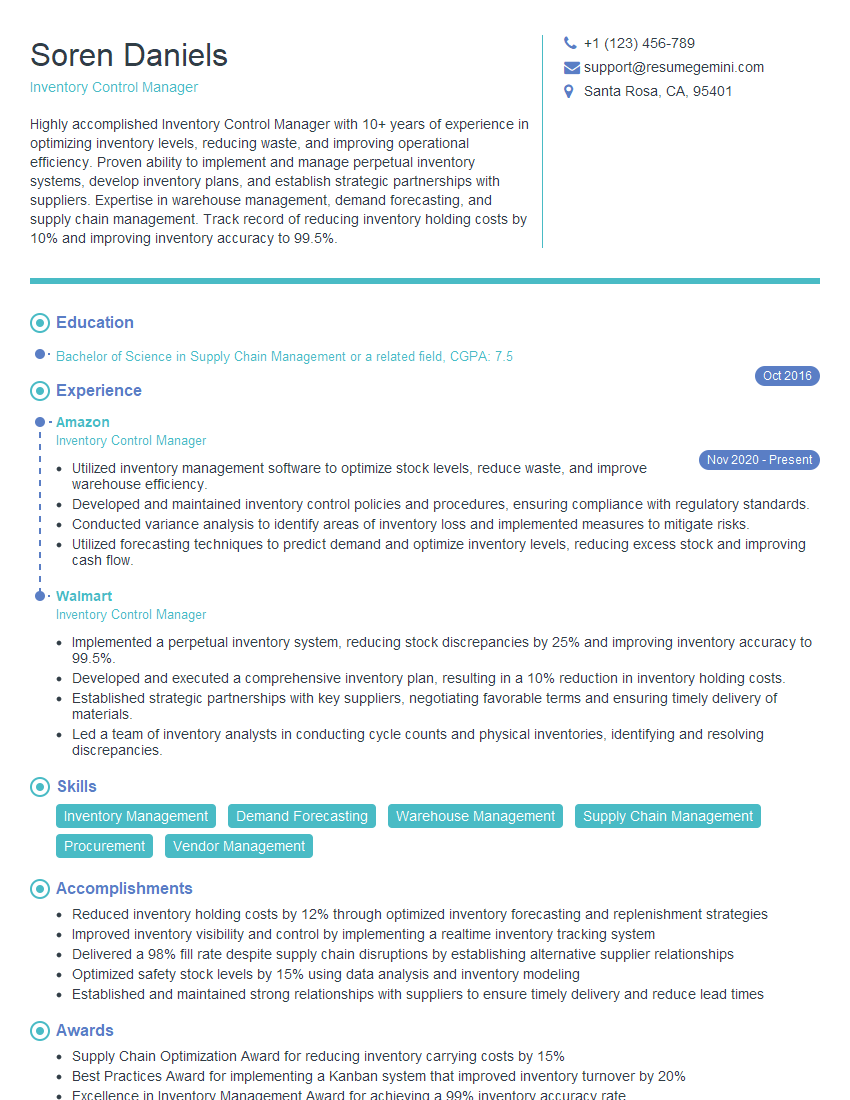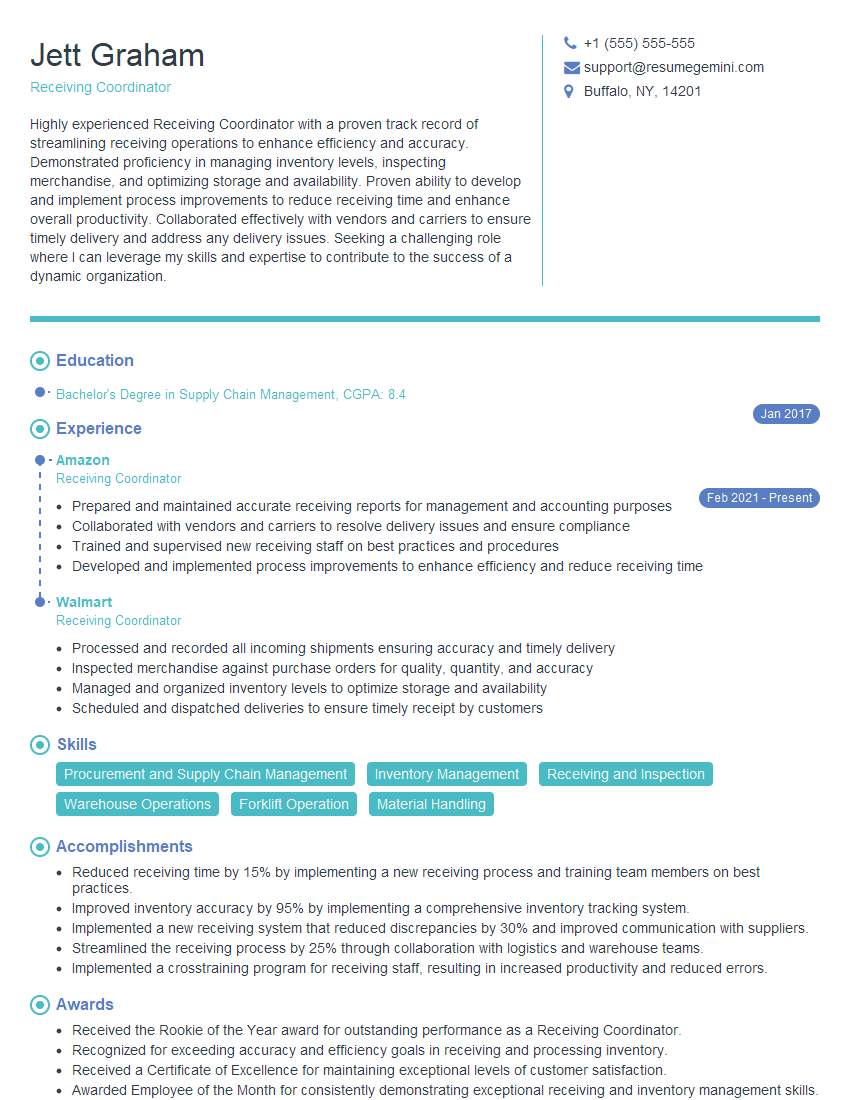Every successful interview starts with knowing what to expect. In this blog, we’ll take you through the top Ground Transportation and Logistics interview questions, breaking them down with expert tips to help you deliver impactful answers. Step into your next interview fully prepared and ready to succeed.
Questions Asked in Ground Transportation and Logistics Interview
Q 1. Explain the difference between LTL and FTL shipping.
LTL (Less-than-Truckload) and FTL (Full Truckload) shipping refer to different ways of transporting goods by truck. The key difference lies in how much space you occupy on the truck.
FTL involves renting an entire truck for your shipment. This is ideal for large shipments where you need the entire truck’s capacity. Think of it like chartering a private jet – you get exclusive use of the vehicle and the speed and efficiency that entails. This leads to faster transit times as your goods are not subject to multiple stops for consolidation or de-consolidation.
LTL, on the other hand, means sharing a truck with other shippers. Your goods are consolidated with shipments from multiple companies going to similar destinations. This is more cost-effective for smaller shipments, similar to sharing a ride with others – the cost is divided among multiple users. However, it typically means longer transit times due to multiple stops along the way.
Example: A furniture manufacturer shipping a large container of sofas would likely use FTL. A small business sending a few boxes of documents across the country would probably opt for LTL.
Q 2. Describe your experience with Transportation Management Systems (TMS).
I have extensive experience with Transportation Management Systems (TMS). I’ve worked with several leading TMS platforms, including Oracle Transportation Management and Blue Yonder, implementing, configuring, and optimizing them for various clients in different industries. My experience ranges from system selection and implementation to day-to-day operational management and strategic optimization.
My responsibilities included integrating the TMS with existing ERP and WMS systems, configuring routing and dispatching rules, analyzing transportation costs, and improving carrier selection processes. I’ve successfully leveraged TMS data analytics to identify cost savings, reduce transit times, and improve overall supply chain visibility. For instance, in one project, we optimized carrier selection using a TMS algorithm, resulting in a 15% reduction in transportation costs within six months.
Furthermore, I’m proficient in using TMS functionality for tasks such as shipment tracking, exception management, and performance reporting. I am confident in my ability to leverage TMS technology to enhance efficiency and reduce costs within any ground transportation operation.
Q 3. What are the key performance indicators (KPIs) you monitor in ground transportation?
In ground transportation, several key performance indicators (KPIs) are crucial for assessing efficiency and profitability. These include:
- On-Time Delivery Rate: The percentage of shipments delivered on or before the scheduled delivery date. This is a critical measure of service reliability.
- Cost per Mile: The total transportation cost divided by the total miles driven. This helps track fuel efficiency and operational costs.
- Freight Spend: The total amount spent on freight services. Analyzing trends can highlight areas for cost reduction.
- Average Transit Time: The average time it takes to move shipments from origin to destination. Shorter transit times indicate greater efficiency.
- Delivery Accuracy: The percentage of shipments delivered to the correct destination and recipient. Accurate deliveries are essential for customer satisfaction.
- Driver Turnover Rate: High driver turnover indicates potential problems with compensation, working conditions, or management. Reducing turnover is key for maintaining service quality.
- Claims Rate: The number of damage or loss claims filed per shipment. A low claims rate indicates efficient handling and secure transportation.
Monitoring these KPIs provides valuable insights into operational performance and identifies areas for improvement. Regular analysis of these metrics allows for data-driven decision-making and proactive adjustments to improve efficiency and reduce costs.
Q 4. How do you optimize delivery routes for efficiency?
Optimizing delivery routes is a crucial aspect of efficient ground transportation. I utilize various methods to achieve this, including:
- Route Planning Software: Sophisticated route optimization software considers factors such as distance, traffic conditions, delivery windows, and driver availability to create the most efficient routes. These systems often use algorithms like Dijkstra’s algorithm or more advanced techniques that factor in real-time traffic data.
- Geographic Information Systems (GIS): GIS technology helps visualize delivery locations, identify potential road closures or traffic congestion, and plan routes to avoid delays.
- Load Consolidation: Combining multiple smaller deliveries into larger shipments to reduce the number of trips needed, improving both efficiency and cost-effectiveness.
- Strategic Depot Location: Optimizing the location of warehouses and distribution centers to minimize transportation distances. This leverages principles from facility location modeling.
- Real-time Tracking and Adjustments: Monitoring shipments in real-time allows for dynamic adjustments to routes based on unforeseen events such as traffic accidents or weather conditions. This often involves the use of GPS tracking and communication systems.
By combining these techniques, we can significantly reduce transportation costs, improve delivery times, and enhance overall operational efficiency.
Q 5. Explain your experience with various modes of ground transportation (e.g., truckload, less-than-truckload, rail).
My experience encompasses various ground transportation modes. I’ve managed and optimized operations involving:
- Truckload (TL): I’ve negotiated contracts with trucking companies, managed FTL shipments, and optimized load planning to minimize empty miles and maximize cost-efficiency. I’ve worked with both dedicated contract carriage and spot market options, selecting the best approach based on the specific needs of each project.
- Less-than-Truckload (LTL): I have experience in consolidating LTL shipments, selecting appropriate carriers based on pricing and transit time, and utilizing LTL freight management systems to track and manage shipments efficiently. This included understanding LTL classifications and their impact on pricing.
- Rail: I’ve coordinated rail transportation for large-scale projects, working closely with rail carriers to arrange shipments, manage intermodal transfers, and ensure timely delivery. This includes understanding the benefits and limitations of rail transport, especially for long distances and high-volume shipments.
In each case, I’ve focused on selecting the most appropriate mode based on factors like shipment size, distance, cost, transit time, and cargo characteristics. My approach emphasizes balancing cost optimization with reliable service and efficient execution.
Q 6. How do you manage unexpected delays or disruptions in the transportation process?
Unexpected delays and disruptions are inevitable in ground transportation. My strategy for managing these situations includes:
- Proactive Monitoring: Utilizing real-time tracking systems to identify potential issues early on. This allows for prompt intervention and mitigation strategies.
- Contingency Planning: Developing backup plans for potential disruptions like weather events, traffic congestion, or equipment failures. This might involve identifying alternative routes or carriers.
- Communication: Maintaining open and transparent communication with customers, carriers, and internal teams to keep everyone informed of any delays and potential solutions.
- Problem-Solving: Analyzing the root cause of any delays to identify areas for improvement in future operations. This often involves identifying the bottleneck and re-routing or implementing proactive changes.
- Exception Management: Establishing clear procedures for handling exceptions and prioritizing urgent issues.
For example, during a severe snowstorm, I successfully rerouted several shipments to avoid major delays using real-time traffic updates and communication with drivers. The proactive approach minimized disruption and ensured customer satisfaction.
Q 7. Describe your experience with warehouse management systems (WMS).
My experience with Warehouse Management Systems (WMS) is extensive and encompasses various aspects of warehouse operations, including inventory management, order fulfillment, and receiving. I’ve worked with various WMS platforms, such as Manhattan Associates and SAP EWM, implementing and optimizing them for maximum efficiency.
My responsibilities have involved configuring WMS parameters, integrating it with other systems like TMS and ERP, and optimizing warehouse layouts to improve workflow. I’ve used WMS data to analyze key performance indicators (KPIs) such as inventory accuracy, order fulfillment time, and warehouse utilization. In one project, I implemented a new WMS resulting in a 20% reduction in order fulfillment time.
Furthermore, I’m experienced in using WMS functionalities for tasks like cycle counting, putaway optimization, and labor management. My focus is always on leveraging WMS technology to create a streamlined and efficient warehouse operation that directly supports the overall ground transportation strategy.
Q 8. How do you ensure compliance with transportation regulations (e.g., DOT, FMCSA)?
Ensuring compliance with regulations like those from the Department of Transportation (DOT) and the Federal Motor Carrier Safety Administration (FMCSA) is paramount for any ground transportation operation. It’s not just about avoiding penalties; it’s about ensuring safety and maintaining operational integrity. My approach is multi-faceted:
- Proactive Training: All drivers and relevant personnel receive regular training on current regulations, including hours-of-service (HOS) rules, vehicle maintenance requirements, and hazardous materials handling. We use a combination of online modules, classroom sessions, and in-person coaching to reinforce learning.
- Regular Audits and Inspections: We conduct internal audits to ensure compliance with all relevant regulations. This includes reviewing driver logs, vehicle maintenance records, and safety procedures. We also proactively schedule Department of Transportation (DOT) compliant inspections of our vehicles to catch potential issues early.
- Record Keeping and Documentation: Meticulous record-keeping is critical. We utilize a robust Transportation Management System (TMS) to digitally track all aspects of our operations, from driver logs to maintenance records. This makes auditing easier and ensures we have the necessary documentation to demonstrate compliance.
- Third-Party Compliance Assistance: We leverage specialized consultants to ensure we remain updated on evolving regulations and to help us identify and address any potential compliance gaps. This provides an external perspective and helps maintain a robust compliance program.
- Incident Reporting and Investigation: A thorough incident reporting and investigation process is in place to identify root causes of accidents and safety violations, allowing us to implement corrective actions and prevent future occurrences.
For example, we recently updated our driver training program to reflect changes in the ELD (Electronic Logging Device) mandate, ensuring all our drivers are compliant with the new HOS regulations. This proactive approach has minimized the risk of fines and ensured the safety of our drivers and the public.
Q 9. What is your experience with load planning and optimization?
Load planning and optimization is about maximizing efficiency and minimizing costs by strategically arranging freight within vehicles and across routes. My experience involves using a variety of techniques:
- Route Optimization Software: I’m proficient in using route optimization software to determine the most efficient routes, considering factors like distance, traffic patterns, and delivery deadlines. This minimizes fuel consumption and transit time.
- Load Consolidation: I strategize to consolidate shipments whenever possible to reduce the number of trips required and optimize vehicle utilization. This often involves coordinating with multiple shippers and recipients.
- Dimensional Weight Calculation: Accurate calculation of dimensional weight is crucial for optimizing load capacity and avoiding excess charges. I have a deep understanding of how this impacts costs and how to minimize dimensional weight discrepancies.
- Load Sequencing: The order in which deliveries are made significantly impacts overall efficiency. I develop delivery sequences that minimize travel time and ensure timely deliveries, considering factors like traffic and delivery windows.
- Data Analysis: I leverage data analysis to identify patterns and trends in shipments, helping to proactively optimize future load planning. This includes analyzing historical data on delivery times, distances, and fuel consumption.
For instance, by implementing a new route optimization algorithm, we reduced our overall delivery time by 15% and fuel consumption by 10% in a recent project. The key is combining software tools with a deep understanding of operational constraints to create truly effective load plans.
Q 10. How do you handle carrier negotiations and contract management?
Carrier negotiations and contract management are crucial for maintaining cost-effective and reliable transportation services. My approach involves:
- Building Strong Relationships: I focus on developing long-term relationships with carriers, based on trust and mutual benefit. This ensures preferential treatment and better rates in the long run.
- Negotiating Favorable Rates: I leverage my market knowledge and negotiation skills to secure competitive rates. This involves researching market rates, understanding carrier capacity, and presenting compelling arguments.
- Contract Drafting and Review: I’m skilled in drafting and reviewing contracts to ensure they protect our interests while providing fair terms to carriers. This includes clearly defining service levels, payment terms, and liability clauses.
- Performance Monitoring: I establish Key Performance Indicators (KPIs) to track carrier performance against contract agreements. This ensures carriers meet our expectations and allows for timely adjustments if needed.
- Risk Management: I proactively identify and mitigate risks, such as carrier financial instability or service disruptions, by diversifying our carrier base and incorporating contingency plans.
In one specific case, I negotiated a long-term contract with a key carrier that resulted in a 12% reduction in our transportation costs. This involved a careful analysis of their capabilities, our shipping volumes, and the current market conditions.
Q 11. Explain your experience with freight auditing and cost analysis.
Freight auditing and cost analysis are essential for identifying cost savings and ensuring accurate invoicing. My experience encompasses:
- Auditing Freight Bills: I meticulously review freight bills for accuracy, identifying and rectifying discrepancies such as incorrect charges, accessorial fees, and overcharges. This often involves using specialized auditing software.
- Cost Tracking and Reporting: I establish systems for tracking and reporting transportation costs, analyzing data to identify trends and areas for improvement. This includes analyzing fuel surcharges, accessorial charges, and other relevant cost components.
- Identifying Cost Savings Opportunities: Through analysis, I identify and implement strategies to reduce transportation costs. This may involve renegotiating contracts, optimizing routes, or consolidating shipments.
- Benchmarking and Analysis: I benchmark our transportation costs against industry averages and best practices to identify opportunities for improvement and to maintain cost competitiveness.
- Data Visualization: I use data visualization techniques to present cost analysis findings in a clear and understandable manner, facilitating informed decision-making.
For example, a thorough freight audit revealed a consistent overcharging by one carrier on fuel surcharges. Addressing this resulted in significant cost savings over the course of a year.
Q 12. Describe your experience with inventory management and control.
Effective inventory management and control are essential for optimizing operational efficiency and minimizing waste. My experience includes:
- Demand Forecasting: I utilize various techniques, including statistical modeling and historical data analysis, to forecast future inventory needs, optimizing stock levels and minimizing storage costs.
- Inventory Tracking and Management Systems: I’m experienced in using inventory management systems (IMS) to track inventory levels, monitor stock movements, and manage stock replenishment processes.
- Warehouse Management: I understand the principles of efficient warehouse management, including storage optimization, order fulfillment processes, and inventory control procedures.
- Inventory Optimization Techniques: I apply various inventory optimization techniques, such as Just-in-Time (JIT) inventory management and Economic Order Quantity (EOQ) calculations, to minimize inventory holding costs.
- Cycle Counting and Physical Inventories: I implement regular cycle counting procedures and periodic physical inventories to ensure the accuracy of inventory records.
In a previous role, I implemented a new inventory management system that reduced stockouts by 20% and optimized warehouse space utilization by 15%, directly impacting operational efficiency and profitability.
Q 13. How do you manage driver relations and performance?
Managing driver relations and performance is crucial for maintaining a safe and productive workforce. My approach focuses on:
- Open Communication: I foster open communication channels between management and drivers to address concerns, provide feedback, and promote a positive work environment.
- Performance Monitoring and Evaluation: I establish clear performance metrics and regularly monitor driver performance against these metrics. This includes tracking safety records, on-time delivery rates, and fuel efficiency.
- Incentive Programs: I implement incentive programs to reward safe driving behavior and high performance. This can include bonuses, recognition programs, and other rewards.
- Driver Training and Development: I provide ongoing training and development opportunities to enhance driver skills, including safety training, defensive driving techniques, and route optimization strategies.
- Conflict Resolution: I develop and implement strategies for resolving conflicts between drivers and management, ensuring a fair and equitable resolution process.
For example, I implemented a driver recognition program that celebrated safe driving milestones and resulted in a significant reduction in accidents and improved overall driver morale.
Q 14. How do you utilize technology to improve efficiency in ground transportation?
Technology plays a vital role in improving efficiency in ground transportation. I leverage several technologies to optimize operations:
- Transportation Management Systems (TMS): TMS software provides a centralized platform for managing all aspects of transportation operations, including route planning, dispatching, tracking, and reporting. This streamlines processes and improves visibility.
- Electronic Logging Devices (ELDs): ELDs automate driver logs, ensuring compliance with hours-of-service regulations and providing valuable data for optimizing routes and driver schedules.
- GPS Tracking and Telematics: GPS tracking and telematics systems provide real-time location data, enabling efficient dispatching, monitoring of vehicle performance, and improved response times to incidents.
- Mobile Apps and Communication Tools: Mobile apps and communication tools facilitate seamless communication between drivers, dispatchers, and customers, enhancing coordination and responsiveness.
- Data Analytics and Business Intelligence: Data analytics tools help to identify trends, patterns, and areas for improvement in operations, enabling data-driven decision-making.
For instance, the implementation of a TMS resulted in a 10% reduction in delivery times and a 5% reduction in fuel consumption by providing real-time visibility and optimized route planning. This highlights how technology can significantly enhance efficiency and reduce operating costs in ground transportation.
Q 15. What strategies do you use to reduce transportation costs?
Reducing transportation costs requires a multifaceted approach focusing on efficiency and strategic planning. It’s not about cutting corners, but optimizing every aspect of the process.
- Route Optimization: Utilizing route planning software to determine the most efficient routes, minimizing mileage and fuel consumption. For instance, I once implemented a route optimization system that reduced our delivery distances by 15%, resulting in significant fuel savings.
- Load Consolidation: Combining shipments to maximize truck capacity. This reduces the number of trips needed, leading to lower fuel costs and labor expenses. Imagine shipping multiple smaller orders from the same region in one truck instead of multiple individual deliveries.
- Negotiating Carrier Rates: Building strong relationships with carriers and leveraging volume discounts to secure better rates. This requires skillful negotiation and understanding market trends.
- Fuel Management: Implementing fuel-efficient driving practices, regular vehicle maintenance, and potentially exploring alternative fuels. We once trained drivers on eco-driving techniques, resulting in a 10% reduction in fuel consumption.
- Warehouse Optimization: Efficient warehouse layout and inventory management can minimize loading and unloading times, improving overall efficiency. This includes strategic placement of frequently shipped items.
The key is to analyze your current processes meticulously, identify areas for improvement, and implement data-driven solutions. A combination of these strategies often delivers the best results.
Career Expert Tips:
- Ace those interviews! Prepare effectively by reviewing the Top 50 Most Common Interview Questions on ResumeGemini.
- Navigate your job search with confidence! Explore a wide range of Career Tips on ResumeGemini. Learn about common challenges and recommendations to overcome them.
- Craft the perfect resume! Master the Art of Resume Writing with ResumeGemini’s guide. Showcase your unique qualifications and achievements effectively.
- Don’t miss out on holiday savings! Build your dream resume with ResumeGemini’s ATS optimized templates.
Q 16. Explain your experience with different types of freight (e.g., hazardous materials, temperature-sensitive goods).
My experience encompasses handling diverse freight types, each with its unique challenges and regulations. Safety and compliance are paramount in all cases.
- Hazardous Materials (HazMat): I’ve managed the transportation of various HazMat materials, adhering strictly to DOT regulations, including proper documentation, packaging, and driver training. This involves understanding specific hazard classes and selecting appropriate transport vehicles and routes. A memorable experience involved a shipment of flammable liquids, requiring specialized tankers and meticulous route planning to avoid populated areas.
- Temperature-Sensitive Goods: I’ve overseen the transportation of pharmaceuticals and other temperature-sensitive goods, utilizing refrigerated trucks (reefers) with real-time temperature monitoring. This requires precise temperature control, continuous monitoring, and contingency plans in case of equipment failure. We once had a reefer unit malfunction; our immediate response prevented a major loss of product.
- Oversized/Heavyweight Cargo: Experience includes coordinating the transport of oversized or heavyweight items, requiring special permits, escorts, and route planning to ensure safe and legal transit. This involves careful consideration of bridge weight limits, road clearances, and potential traffic disruptions.
Each freight type requires specialized knowledge, meticulous planning, and strict adherence to regulations. Failure to comply can lead to significant financial and legal repercussions.
Q 17. How do you ensure on-time delivery and meet customer service level agreements (SLAs)?
On-time delivery and meeting SLAs are fundamental to customer satisfaction and business success. This relies on proactive planning, robust tracking systems, and a commitment to excellence.
- Proactive Planning: Accurate forecasting of demand, efficient scheduling, and contingency planning for potential delays (traffic, weather, etc.). This includes building buffer time into delivery schedules.
- Real-time Tracking: Employing GPS tracking systems to monitor vehicle locations, speed, and potential delays, allowing for proactive interventions. I’ve used several systems, and the data allows us to notify customers of potential delays and adjust schedules accordingly.
- Communication: Maintaining open communication with drivers, customers, and internal stakeholders to keep everyone informed and address any potential issues promptly.
- Driver Management: Investing in driver training and performance management to ensure adherence to schedules and safety regulations.
- Data Analysis: Regularly analyzing delivery data to identify trends, areas for improvement, and potential bottlenecks in the delivery process.
By combining these strategies, we consistently achieve high on-time delivery rates and maintain strong customer relationships.
Q 18. Describe your experience with using GPS tracking and fleet management software.
GPS tracking and fleet management software are indispensable tools for optimizing operations and improving efficiency. They provide real-time visibility and data-driven insights.
- GPS Tracking: I have extensive experience using various GPS tracking systems to monitor vehicle locations, speeds, idle times, and driving behavior. This data is crucial for route optimization, fuel efficiency analysis, and identifying potential safety issues.
- Fleet Management Software: I’ve utilized software platforms that integrate GPS data with other operational information, such as driver logs, maintenance records, and fuel consumption. This allows for comprehensive fleet management, performance analysis, and improved decision-making.
- Data Analysis and Reporting: The software allows for generating customized reports to track key performance indicators (KPIs) like fuel efficiency, on-time delivery rates, and driver performance. This data informs strategic decisions and drives continuous improvement.
For example, one software platform I used allowed us to identify a pattern of excessive idling during deliveries, leading to a targeted driver training program that reduced fuel consumption and improved delivery times.
Q 19. How do you handle claims and disputes related to damaged goods or late deliveries?
Handling claims and disputes requires a fair, transparent, and efficient process. The goal is to resolve issues amicably and maintain customer satisfaction.
- Documentation: Maintaining meticulous records, including delivery receipts, proof of delivery (POD), and photographs of damaged goods. Proper documentation is crucial for supporting claims.
- Investigation: Thoroughly investigating each claim to determine the cause of damage or delay. This may involve reviewing GPS data, driver logs, and communicating with all involved parties.
- Communication: Maintaining open communication with the customer throughout the claims process, keeping them informed of the progress and resolution. This prevents misunderstandings and maintains trust.
- Insurance Claims: Filing insurance claims as appropriate to recover costs associated with damaged goods or delivery delays. It’s important to have comprehensive insurance coverage.
- Negotiation and Resolution: Negotiating fair settlements with customers and carriers, aiming for mutually acceptable outcomes. Sometimes mediation may be necessary.
Our goal is to resolve disputes swiftly and fairly, maintaining positive relationships with our customers and carriers.
Q 20. Explain your experience with implementing and managing transportation safety programs.
Implementing and managing transportation safety programs are critical for minimizing risks, ensuring driver well-being, and complying with regulations. A strong safety culture is paramount.
- Driver Training: Providing comprehensive driver training programs covering defensive driving techniques, safety regulations, and hazard awareness. This includes regular refresher courses.
- Vehicle Maintenance: Establishing a robust vehicle maintenance program to ensure vehicles are in optimal condition, minimizing mechanical breakdowns and safety hazards. Regular inspections are critical.
- Safety Audits and Inspections: Conducting regular safety audits and vehicle inspections to identify potential hazards and ensure compliance with regulations. This might involve DOT compliance checks.
- Safety Policies and Procedures: Developing and implementing clear safety policies and procedures, ensuring all drivers and personnel are aware of their responsibilities and understand the procedures.
- Incident Reporting and Investigation: Establishing a system for reporting and thoroughly investigating all accidents and incidents, identifying root causes, and implementing corrective actions. Data-driven insights inform future safety measures.
A proactive approach to safety significantly reduces risks, improves driver performance, and strengthens the company’s reputation.
Q 21. Describe your experience with international ground transportation.
International ground transportation presents unique challenges compared to domestic operations, requiring a deeper understanding of customs regulations, international trade laws, and cross-border logistics.
- Customs Brokerage: Working with customs brokers to ensure smooth and efficient clearance of goods through customs. This involves proper documentation, classification of goods, and adherence to import/export regulations.
- International Regulations: Navigating the complexities of different countries’ regulations, including differing road laws, weight limits, and documentation requirements. This often requires working with local partners.
- Cross-Border Logistics: Coordinating the movement of goods across international borders, often involving multiple carriers and intermediaries. This necessitates effective communication and close monitoring of shipments.
- Incoterms: Understanding and applying Incoterms rules to define responsibilities and costs associated with international shipments. This clarity prevents disputes and ensures efficient processing.
- Language and Cultural Differences: Communicating effectively with international partners and overcoming language and cultural barriers. This may involve translation services or the need for culturally sensitive approaches.
I have successfully managed several international ground transport projects, working collaboratively with international partners to deliver goods safely and efficiently while navigating the intricacies of global logistics.
Q 22. How do you manage risk and mitigate potential issues in the supply chain?
Managing risk in the supply chain is paramount. It’s not about avoiding risk entirely – that’s impossible – but about identifying, assessing, and mitigating potential disruptions. My approach involves a multi-pronged strategy encompassing proactive measures and reactive responses.
Proactive Risk Management: This includes thorough supplier relationship management, diversifying sourcing to avoid over-reliance on a single supplier, robust contract negotiations with clear contingency plans, and continuous monitoring of geopolitical events, weather patterns, and other potential disruptions. For example, during the recent chip shortage, having multiple semiconductor suppliers allowed us to navigate the crisis with minimal impact.
Reactive Risk Management: This involves establishing clear communication channels, having a pre-defined crisis management plan, and developing robust contingency plans. For instance, if a port strike occurs, having alternative transportation routes (e.g., rail) already identified allows for a swift transition, minimizing delays.
Technology Integration: Utilizing supply chain visibility platforms and advanced analytics allows for real-time monitoring of shipments, enabling early detection of potential issues. We can use this data to proactively adjust schedules and routes to avoid delays.
Insurance and Financial Planning: Adequate insurance coverage and financial reserves are crucial to absorb unexpected shocks. This includes cargo insurance, business interruption insurance, and maintaining healthy financial buffers.
Q 23. What is your experience with last-mile delivery strategies?
Last-mile delivery is the final leg of the supply chain, and optimizing this stage is crucial for customer satisfaction and profitability. My experience includes implementing and managing various last-mile strategies, including:
Crowdsourced Delivery: Utilizing independent contractors or gig economy platforms offers scalability and flexibility, particularly for peak seasons or geographically dispersed deliveries. We’ve successfully employed this for smaller, time-sensitive packages.
Dedicated Fleet: Maintaining a company-owned fleet provides greater control over delivery times, driver behavior, and brand image. This approach is ideal for high-value or fragile goods, where consistent quality and reliability are paramount.
Route Optimization Software: Implementing route optimization software significantly improves efficiency by minimizing travel times and fuel consumption. I’ve worked with various software solutions, carefully selecting those that best fit our specific needs and scale.
Delivery Appointment Scheduling: Offering customers the ability to schedule their deliveries enhances convenience and reduces failed delivery attempts. This significantly reduces operational costs and improves customer satisfaction.
Micro-fulfillment Centers: Strategically located smaller warehouses closer to customers allows for faster delivery times and reduced transportation costs, particularly in densely populated areas. This is a growing area of focus in our company.
Q 24. Describe your experience with different warehousing methods (e.g., cross-docking, just-in-time).
I have extensive experience with various warehousing methods, each offering unique advantages and disadvantages depending on the specific needs of the business.
Cross-docking: This method involves receiving goods from suppliers and immediately transferring them to outbound trucks, minimizing storage time and costs. It’s ideal for high-volume, fast-moving goods. We’ve successfully implemented this for perishable goods, reducing spoilage and improving freshness.
Just-in-Time (JIT): JIT inventory management minimizes inventory holding costs by receiving goods only when they are needed. This requires a highly efficient and synchronized supply chain. We have used JIT successfully for automotive components, where timely delivery is critical for assembly line efficiency.
Value-Added Services Warehousing: This involves offering services beyond basic storage, such as labeling, packaging, kitting, or light assembly. This can greatly enhance product value and reduce the burden on the manufacturer. We have used this strategy effectively for electronics and furniture companies.
Choosing the appropriate warehousing method requires a thorough analysis of factors like product type, demand variability, lead times, and cost considerations. A flexible approach that combines elements of different methods often proves most effective.
Q 25. How do you utilize data analytics to improve transportation operations?
Data analytics plays a critical role in improving transportation operations. We leverage data from various sources – GPS tracking, shipment manifests, warehouse management systems, and customer relationship management (CRM) – to gain valuable insights and drive efficiency.
Route Optimization: Analyzing historical data on traffic patterns, delivery times, and fuel consumption helps to optimize delivery routes, reducing travel time and fuel costs. We use algorithms to dynamically adjust routes based on real-time traffic conditions.
Predictive Maintenance: By analyzing data from vehicle maintenance logs, we can predict potential equipment failures and schedule preventative maintenance, minimizing downtime and unexpected repair costs.
Capacity Planning: Forecasting demand based on historical sales data and market trends helps optimize warehouse space and transportation capacity, ensuring sufficient resources are available to meet demand.
Performance Monitoring: Tracking key performance indicators (KPIs) such as on-time delivery rates, fuel efficiency, and cost per shipment allows us to identify areas for improvement and measure the effectiveness of implemented changes. Dashboards and reporting tools make this data easily accessible.
Q 26. What is your experience with sustainability initiatives in transportation?
Sustainability is no longer a trend; it’s a necessity. We’re actively engaged in various initiatives to reduce our environmental footprint:
Fuel-efficient vehicles: Transitioning to hybrid and electric vehicles reduces our carbon emissions and lowers fuel costs. We have a phased plan for fleet modernization.
Route optimization for fuel efficiency: As mentioned earlier, data-driven route optimization minimizes fuel consumption, reducing emissions and operational expenses.
Eco-friendly packaging: Using recycled and biodegradable materials reduces waste and promotes environmental responsibility. We’re working with suppliers to source sustainable packaging options.
Carbon offsetting: We’re exploring carbon offsetting programs to compensate for unavoidable emissions.
Driver training programs: Educating drivers on fuel-efficient driving techniques minimizes fuel consumption and emissions.
These initiatives not only benefit the environment but also contribute to a positive brand image and improved operational efficiency.
Q 27. How would you approach a situation where a key supplier experiences a significant disruption?
A significant supplier disruption requires a rapid and coordinated response. My approach involves these steps:
Immediate Assessment: First, I’d assess the severity and scope of the disruption – what’s the impact on our operations, and how long is the disruption expected to last?
Communication: Establish clear communication with all stakeholders – internal teams, customers, and other suppliers. Transparency is crucial during a crisis.
Contingency Plan Activation: Activate pre-defined contingency plans, which might involve sourcing alternative suppliers, rerouting shipments, or adjusting production schedules. We’d leverage our established relationships and diversify supplier network developed during risk management planning.
Problem Solving: Collaborate with the affected supplier to identify the root cause of the disruption and find solutions. Is it a temporary issue or a more permanent problem?
Mitigation and Monitoring: Implement the chosen solutions and closely monitor their effectiveness. Regularly reassess the situation and adjust plans as needed.
Post-Incident Review: After the disruption is resolved, conduct a thorough review to identify lessons learned and improve future preparedness.
The key is proactive planning and preparation. Having contingency plans in place significantly reduces the impact of unexpected disruptions.
Key Topics to Learn for Ground Transportation and Logistics Interview
- Supply Chain Management: Understanding the flow of goods from origin to destination, including warehousing, inventory management, and order fulfillment. Practical application: Analyzing and optimizing delivery routes for cost-effectiveness and efficiency.
- Transportation Modes & Selection: Knowledge of various ground transportation options (trucking, rail, intermodal) and their suitability for different cargo types and distances. Practical application: Justifying the choice of transportation mode based on factors like cost, speed, and reliability.
- Logistics Software & Technology: Familiarity with Transportation Management Systems (TMS), Warehouse Management Systems (WMS), and other relevant software used for route planning, tracking, and fleet management. Practical application: Describing your experience using such systems or your understanding of their functionalities.
- Freight Documentation & Compliance: Understanding Bills of Lading, shipping manifests, and relevant regulations (e.g., hazardous materials handling). Practical application: Explaining how you would ensure compliance with all necessary regulations and documentation procedures.
- Risk Management & Mitigation: Identifying potential risks in ground transportation (e.g., delays, accidents, theft) and developing strategies to mitigate them. Practical application: Developing a contingency plan for potential disruptions to the supply chain.
- Cost Optimization & Budgeting: Analyzing transportation costs and identifying opportunities for cost reduction. Practical application: Explaining methods used to track and control transportation expenses.
- Customer Service & Communication: Effective communication with clients, carriers, and internal teams to ensure smooth operations. Practical application: Describing your experience in handling customer inquiries and resolving transportation issues.
Next Steps
Mastering Ground Transportation and Logistics opens doors to exciting and rewarding career opportunities within a dynamic and ever-evolving industry. To stand out from the competition and make a strong impression on potential employers, a well-crafted resume is crucial. Building an ATS-friendly resume is essential for ensuring your application is seen by recruiters. We highly recommend using ResumeGemini, a trusted resource for building professional and impactful resumes. ResumeGemini provides examples of resumes tailored specifically to Ground Transportation and Logistics to help you craft the perfect application. Take the next step towards your dream career – start building your resume today!
Explore more articles
Users Rating of Our Blogs
Share Your Experience
We value your feedback! Please rate our content and share your thoughts (optional).
What Readers Say About Our Blog
Hi, I’m Jay, we have a few potential clients that are interested in your services, thought you might be a good fit. I’d love to talk about the details, when do you have time to talk?
Best,
Jay
Founder | CEO




